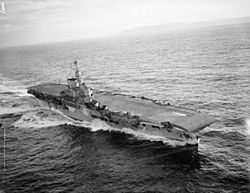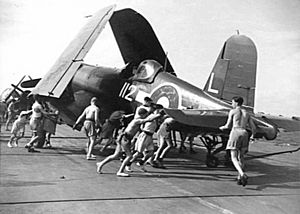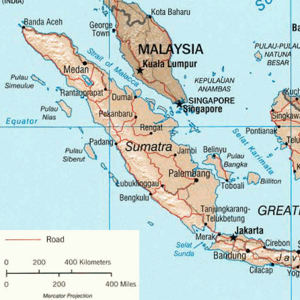Operation Crimson facts for kids
Quick facts for kids Operation Crimson |
|||||||
|---|---|---|---|---|---|---|---|
| Part of the Pacific Theatre of the Second World War | |||||||
 HMS Victorious |
|||||||
|
|||||||
| Belligerents | |||||||
| Commanders and leaders | |||||||
| Strength | |||||||
| 2 aircraft carriers 3 battleships 1 battlecruiser 6 cruisers 10 destroyers 2 submarines 34–39 fighters |
Shore defences 2 reconnaissance aircraft 9–10 fighters |
||||||
| Casualties and losses | |||||||
| Unknown human losses 1 cruiser damaged 2 destroyers damaged 2 fighters destroyed |
Unknown human losses 2 reconnaissance aircraft destroyed 2 fighters destroyed 2 fighters damaged |
||||||
| Civilian casualties: 1 war correspondent on an Allied ship was killed |
|||||||
Operation Crimson was a naval attack during World War II. It happened on July 25, 1944. Allied forces, mainly from Britain, Australia, the Netherlands, and France, attacked Japanese airfields. These airfields were in Indonesian cities like Sabang, Lhoknga, and Kutaraja. The attack involved both ships firing their guns and planes bombing from aircraft carriers in the Indian Ocean.
Contents
Planning the Attack
Why the Attack?
Earlier attacks by the Allies were often small. They were meant to bother the Japanese or distract them. But Operation Crimson was different. It was a much bigger plan. The goal was to cause a lot of damage. The Allies wanted to destroy the Japanese air base and harbor buildings. They also aimed to wreck any ships hiding there.
The Allied Fleet
The Allied fleet, called Task Force 62, sailed from Trincomalee. Admiral James Somerville was in charge. The fleet included two large aircraft carriers, HMS Victorious and Illustrious. These carriers carried many Vought F4U Corsair fighter planes.
The fleet also had powerful battleships like HMS Queen Elizabeth, Valiant, Renown, and the French ship Richelieu. There were also several cruisers, including Ceylon and Cumberland. Ten destroyers, such as HMS Quality and HMAS Quickmatch, joined them. Two submarines, HMS Templar and Tantalus, were also part of the force.
The Operation
Air Attacks
The aircraft carriers launched their Corsair fighter planes. The planes were supposed to attack the airfields. However, it was still too dark for the pilots to see clearly. So, instead of the airfields, they attacked large buildings nearby. Japanese anti-aircraft guns fired back. They shot down one Corsair plane, but its pilot was rescued.
The battleships began firing their huge guns. They aimed at the harbor buildings and army barracks in Sabang. Planes from the carrier Illustrious helped guide their shots. Other ships also found targets. The cruisers attacked a radio station and shore batteries that were firing back. The destroyers focused on a radar station.
After the main shelling, some smaller ships entered Sabang harbor. These included the Dutch ship Tromp and the destroyers Quality, Quickmatch, and Quilliam. They continued to shell Japanese positions and even launched torpedoes. The Japanese fired back with their coastal artillery. These shots lightly damaged all the ships except Quickmatch. Some sailors were hurt, and a war correspondent on one of the ships was killed.
Japanese Response
As the Allied fleet started to leave, two Japanese reconnaissance planes tried to follow them. But Allied planes quickly found and shot down both of them. Later that afternoon, about 9 or 10 Japanese A6M "Zero" fighter planes approached the Allied force. Thirteen Corsairs flew out to meet them. In the fight, the Corsairs destroyed two Zero planes and damaged two more.
After the Battle

The Allies lost two Corsair planes during Operation Crimson. A report about the attack said:
The force arrived at flying off position in the early hours of Tuesday 25 July and at 4am the capital ships were detached to bombard Sambang along with Cumberland, Kenya and Nigeria. At 5.25 a.m. the two carriers launched their aircraft. The raid was a success with a great deal of damage done to the Japanese forces.
British pilots noticed something interesting. They felt that the Japanese pilots were not as skilled as they had been earlier in the war, in 1942. Operation Crimson was the last mission for Admiral Somerville as a military commander. He then moved to a diplomatic role because of health concerns. The British fleet did not launch another major attack until Operation Banquet in August.


